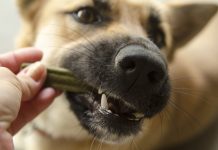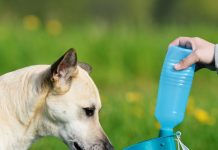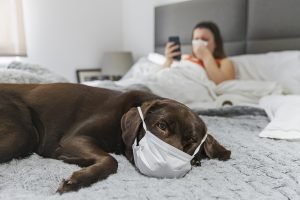 The raging global outbreak of the SARS-CoV-2 incites fears and doubts into people’s minds all around the globe. There are so many sources asserting contradicting things right now that it is important to know what pieces of information to trust, so as not to do anything crazy. Animal lovers are just like everybody else find themselves in this situation, not having a clue on and how to act and care for their beloved animals.
The raging global outbreak of the SARS-CoV-2 incites fears and doubts into people’s minds all around the globe. There are so many sources asserting contradicting things right now that it is important to know what pieces of information to trust, so as not to do anything crazy. Animal lovers are just like everybody else find themselves in this situation, not having a clue on and how to act and care for their beloved animals.
Some of them are afraid to infect their little friends with the bug in questions, others are afraid of contracting the bug, and a lot are simply lost. Trying to figure out this wall of information regarding the pandemic incident is extremely tricky, so let’s figure out how to keep yourself cool if you are a doggy owner and worried about coronavirus dogs.
In this article, we will look at what exactly COVID-19 is, how it affects pooches, whether they can contract and transmit it and other similar viruses, as well as what you should keep in mind when caring for your pup during these times. Without any delaying any further, let’s get to the bottom of this topic.
Pathology of the Virus(es)
The COVID-19 is definitely not the first one of its kind. It belongs to an entire group of similar viruses, coronaviruses. They have existed and targeted mammals and birds for thousands upon thousands of years. This group is called so due to all of the viruses in it having similar physical appearance. Each of the viruses has crown-shaped spikes on the outer border of their bodies.
The virus that is central to the current global is just another evolution and a single representative of this group. In humans, this virus leads to people getting the disease COVID-19, which mainly attacks our respiratory system. The common symptoms for us are heightened temperature, coughing, breath shortness, and muscle pains. In severe forms with complications during the recovery process, some people even get a high fever, pneumonia, and kidney failure.
This particular virus is extremely harmful to us, humans, as it infects both the upper and lower airways. It gets into upper airways, combined with the factor that it efficiently targets the protein ACE2 in our bodies and employs an enzyme that our bodies produce to split and replicate that makes it incredibly infectious. It also gets into lower airways resulting in being very deadly and giving complications much more consistently.
 Due to the danger that this virus poses to humans all around the globe, research into how it impacts our smaller friends, to which living beings it is harmful, and to what degree does it affects each specific animal species is not prioritized. Therefore, the interaction between the virus and canines is not actively studied.
Due to the danger that this virus poses to humans all around the globe, research into how it impacts our smaller friends, to which living beings it is harmful, and to what degree does it affects each specific animal species is not prioritized. Therefore, the interaction between the virus and canines is not actively studied.
For example, a big striped cat in Bronx zoo was positive for the coronavirus, as well a couple of dogs in Hong Kong have picked up the virus too, yet showing no actual coronavirus symptoms in dogs. Also, it is generally thought by the scientific community that the infamous bug was transmitted to us from a vector animal that initially got the infection from horseshoe bats. So, the virus has a proven capacity to attack other species.
However, being capable of entering other species, the particular disease doesn’t seem to be so dangerous to our beloved smaller friends. The officials suggest that COVID-19 has over 2 million human infections worldwide, and proven incidents of it infecting our smaller friends are smaller than 10.
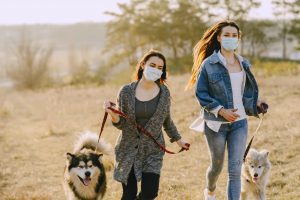 If you are concerned exclusively about how the global pandemic affects your pooch, then the CDC has a detailed piece on this topic. But, the bottom line about the new international disease and pets is that there is generally no necessity in being distressed about it. Just treat your pet like you would your cohabitants and limit its interaction with others outside of your home.
If you are concerned exclusively about how the global pandemic affects your pooch, then the CDC has a detailed piece on this topic. But, the bottom line about the new international disease and pets is that there is generally no necessity in being distressed about it. Just treat your pet like you would your cohabitants and limit its interaction with others outside of your home.
Still, the fact that our little pups are pretty much safe from the global pandemic doesn’t mean that they cannot contract other forms of coronaviruses. So, what is the coronavirus in dogs? In fact, there are two canine-specific bugs of the corona type that target pooches and produce nasty symptoms. The first one is called Canine Coronavirus (CCoV), and it belongs to the group of coronaviruses. Just like the COVID-19 bug, this one has crown-shaped proteins on the outside layer.
Most commonly, the infection with the CCoV is a very short one. Its incubation phase (after the disease enters the body and before any clinical signs show) is only 24 to 72 hours, and the complete recovery time is about a week.
The disease targets and mainly affects the pup’s digestive system, as the small intestine becomes the epicenter for the virus’ breeding. Initially, the virus was discovered in only 1971 year, as a result of its outbreak in sentry dogs in Germany and was thought to cause harsh intestinal damage. This virus usually infects young and adolescent pups.
Most of the time, the illness does not result in any feasible symptoms, and sometimes, the bug produces mild coronavirus symptoms in dogs. They are diarrhea, lethargy, and loss of appetite. The viral pathogen itself is not that dangerous and only leads to severe diarrhea on rare occasions, which can lead to serious dehydration.
 And even more seldom, the bug can mutate into lethal versions of itself. However, that is incredibly improbable. Although the canine bug isn’t a significant threat to your pup’s health on its own, it can make your beloved doggy much more vulnerable to other illnesses, which is the real risk with the CCoV.
And even more seldom, the bug can mutate into lethal versions of itself. However, that is incredibly improbable. Although the canine bug isn’t a significant threat to your pup’s health on its own, it can make your beloved doggy much more vulnerable to other illnesses, which is the real risk with the CCoV.
The other bug that targets dogs is called Canine Respiratory Coronavirus (CRCoV). This one is more similar to SARS-CoV-2, but it still should be said that these two are both completely different viruses. It attacks the respiratory system of the host. The virus’s discovery was incredibly recent, as only in 2003 in the United Kingdom, the new type of the virus was found and isolated in laboratories.
This virus, on its own, can only cause acute respiratory infection, as well as the Canine Infectious Respiratory Sickness. Upon infection, CRCoV weakens the pup’s immune system, which can lead to other respiratory sicknesses and dangerous bacteria and viral pathogens, including herpes, influenza, parainfluenza, and so on.
The common respiratory coronavirus in dogs symptoms that come with this bug is mild and medium coughing, sneezing, and mucus discharge. A large percentage of canines live through the infection absolutely asymptomatically whatsoever. However, CRCoV can rarely lead to severe pneumonia, especially when it’s a part of a serious complex of infections, which includes other bacteria and virus pathogens. Judging by the seriousness of the illness, the recovery period can last up to half a month.
When it comes to CCoV, most of the incidents with this bug come from the interaction with other hosts, in other terms, through both direct and indirect contact of uninfected pups with coronavirus dogs. Due to the nature of this disease, the pet’s intestines are mainly the ones to contain extraneous amounts of bacteria. The bacteria naturally come out of the sick pup with their excrements. So, whenever an uninfected pup either interacts with the pooch that has the bug and sniffs their backside (which is also covered in the viral pathogens, because the infected dog’s stool is so watery) or plays with the excrements in question, it contracts the bug.
The way that CCoV attacks the digestive tract is not the only thing that turns it highly infectious. This bug pretty reliably can remain in the sick pup for almost six months after the pup’s recovery. This factor makes all the difference in the level of the virus’s contagiousness. The canine’s love for playing with and in excrements combined with how the coronavirus persists in the infected individuals makes the infection highly probable.
The CRCoV, too, spreads through direct and indirect contact between uninfected and coronavirus dogs. Seeing how the virus targets the respiratory system, uninfected pooches need to be near the ill individuals and inhale the viral pathogens or lick the infected mucus that the ill individual left on various surfaces.
Basically, this virus acts just like any regular respiratory infection. After the initial 14-day recovery period, the previously sick pooch has little to no chance of transmitting the disease to the other doggies.
In both cases, there was no real proof found to support the claims that both groups of the canine bugs can be transmitted to humans. Either we are not susceptible to the viral pathogens, or it passes through our bodies unnoticed. In both cases, the bugs do not pose any threat of infecting humans.
It needs some emphasis that both CCoV and CRCoV are not the same as SARS-CoV-2. Yes, they belong to the group of the crown-shaped viral pathogens, but they are completely harmless to us, and they do not cause the notorious disease in people!
In the midst of the international pandemic, some of the owners become anxious and even paranoid about their pooch infecting them with the COVID-19 bug, and they decide to get rid of their animal. This is absolutely wrong and immoral. In Wuhan, thousands of various pets were left behind, dumped out on the streets, and simply abandoned without any access to water and food, because people were just trying to “save” themselves. Do not repeat the mistake, and don’t let it be repeated by spreading this message.
 There is a coronavirus vaccine for canines available specifically for CCoV, and it is called DA2PPC. It is a multi-purpose vaccine, as it prevents the infection with a number of viruses. Each letter in the vaccine title stands for a disease against which it treats the pooch. D is canine distemper, A2 is the second type of adenovirus (that also protects from the first type), the first P is for parvovirus, the other P is parainfluenza, and C is, of course, the CCoV.
There is a coronavirus vaccine for canines available specifically for CCoV, and it is called DA2PPC. It is a multi-purpose vaccine, as it prevents the infection with a number of viruses. Each letter in the vaccine title stands for a disease against which it treats the pooch. D is canine distemper, A2 is the second type of adenovirus (that also protects from the first type), the first P is for parvovirus, the other P is parainfluenza, and C is, of course, the CCoV.
The treatment is a preventative measure, and it will help the pup over its course of life. Still, if the canine gets infected anyway (there is a slim possibility of this happening), usual medicine is utilized, including anti-viral and antibiotics, to prevent complications during recovery and further infections.
There is no coronavirus in dogs vaccine for CRCoV. Nonetheless, you may have noticed that the vaccine mentioned above treats common viruses that attack the respiratory system. This means that even if your beloved doggie gets the type II coronavirus, it will still be fine because the illness will not progress into a severe state and will not result in a whole complex of infections.
Although CCoV is considered a mild disease, deaths from it have increased as of lately. This is all because of coinfection. So, if your dog shows any signs of being sick with the virus, understanding the level of threat that the infection poses to your pet is essential. The same goes for CRCoV since this infection should not be left alone when it does not pass in your pup asymptomatically (without any symptoms).
If this is the first time you tackling these infections, then you should definitely visit a local veterinarian. They will advise you on what you will need to do to help and whether you need to do anything at all for your beloved animal. The veterinarians are sure to have the necessary tests in place.
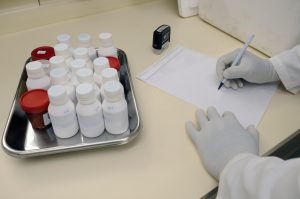 Still, you can come prepared. To test for the type I coronavirus infection in dogs (CCoV), the vet will most likely need a sample of the pooch’s stool. For type II, you do not need to prepare because the vet will take the sample for the test from the nose and mouth cavities.
Still, you can come prepared. To test for the type I coronavirus infection in dogs (CCoV), the vet will most likely need a sample of the pooch’s stool. For type II, you do not need to prepare because the vet will take the sample for the test from the nose and mouth cavities.
If you are a dog breeder, then you should know that the tests in question can all be bought for home use. Buying them will aid your efforts significantly because knowing whether your dogs are sick with particular viruses will allow you to isolate the infected doggies as required, so as no to let the viruses spread.
Both types of canine coronaviruses seem to be almost ubiquitous. People find dogs that have the antibodies against the infections all over the world, and the most interesting part is that they picked out the pooches had no previously coronavirus in dogs vaccine administered. This means they have survived the disease on their own.
The antibody is a special protein that the pup’s immune system produces to fight any virus or hostile invader bacteria. Just like in humans, whenever the pooch recovers from a new infection, the immune system updates its “database of known infections,” and with it, the antibodies update, too.
A small amount of them still runs through the blood of the canine even if it is not sick at the moment. This is done to detect any hostile viruses and bacteria, as the main part of the antibody starts to fight the invading species while a small part of the protein is sent back to the humoral system to ask for the urgent creation of new antibodies.
This factor allows us to execute the antibody screening test easily. The tests show that a majority of dogs live through both of the infections throughout their lives. Most likely, the viruses have existed for hundreds (if not thousands) of years before their discovery. Dog DNA test can reveal the illnesses that your pup is prone to before they even occur.
 Due to the instability of symptoms of CCoV (they can be present or not), clinical signs are not used to determine whether any particular pup has the coronavirus. Veterinarians employ immunoassays to detect the infection. This is a test that basically targets one virus specifically in a given sample by seeing whether there any viral antigens of one type are detected by a special agent. These tests are very quick, taking up only up to twenty minutes.
Due to the instability of symptoms of CCoV (they can be present or not), clinical signs are not used to determine whether any particular pup has the coronavirus. Veterinarians employ immunoassays to detect the infection. This is a test that basically targets one virus specifically in a given sample by seeing whether there any viral antigens of one type are detected by a special agent. These tests are very quick, taking up only up to twenty minutes.
CRCoV has basically the same clinical signs as most other viruses that attack the respiratory system, which is why symptoms, again, are not used to diagnose the virus. Instead, veterinarians use panels, which are quick tests that figure out which viral respiratory infections the pup has from a little swab from mouth and nose. Just like the previous one, the panel is very quick to show the results, which enhances a swift start of treatment against the disease and allows to coronavirus vaccine dogs later on.
Regarding the CCoV, there are tons of other infections that show similar clinical signs and make the process of correctly diagnosing your pet incredibly hard. Firstly, numerous parasites lead to excessive diarrhea. Coccidia is a great common example of this, as this bug usually resides in soil, and many dogs get it into their mouths regularly.
Outside of parasites, there are also other types of viruses that cause the same symptoms, including parvovirus. The clinical signs are absolutely the same, so testing must be conducted in order to figure out the disease.
The CRCoV is just as hard to diagnose as it resembles just about every usual respiratory infection, such as influenza, adenovirus, herpes, CIRD, and many-many more. In both cases, the symptoms are too ubiquitous for them to say a lot about the infection.
The general pointer for dog owners is to wait a day (when you first notice the clinical signs) to see whether your pup gets any better. If not, then go to a vet. In the case your dog gets better on their own, most likely, their immune system has successfully dealt with the invader on its own.
Vaccination is a preventative measure. It means that you cannot use coronavirus dogs vaccine to battle the existing and ongoing infection in a pooch since that task goes to various treatments that have to help your pup deal with the viruses and bacteria. Vaccination should not be approached in terms “when it’s needed,” as it should be a part of every healthy pup’s life.
Seeing as how CRCoV doesn’t have a vaccine, let’s talk solely about the first type of canine coronavirus. Vaccination for it is considered non-essential by professionals, but you can add it to the routine vaccination if you so desire. Still, if you want to ensure the good health of your pup, then treatment against coronavirus should be implemented. There is a vaccination that should be given at the start, at ten to twelve weeks, and then, the coronavirus vaccine in dogs should be administered every one to two years.
The main reason is prevention, of course. If your dog has a lot of exposure to other dogs and people, and if you are not keeping your pooch in your house all of the time (and hopefully, you are not doing that outside of the quarantine), then the vaccination should occur. This should be a simple safety measure, especially if you are housing many canines at your home. By keeping your pups safe and healthy, you also minimize the risk factor of any human diseases getting to you and your family.
The pups that are most likely to pick the CCoV up are those that live in crowded and unsanitary environments. For example, pooches in shelters and boarding kennels are prone to infections, so vaccination is a necessity.
Besides, it shows that doggies, service pooches, and helper pups also require vaccination so as not to be susceptible to infections and be ready to carry out their duties. Simply said, all pups with a lot of interaction should be vaccinated because they will inevitably confront numerous dangerous viruses and bacteria throughout their lives.
The question of the CCoV origin is not yet answered, and it will most likely stay so forever. Scientists believe that the first recorded outbreak of it in 1971 in Germany is not the first real occurrence of it. It is simply a first documented case of it.
Whether this virus evolved from other viruses of the same group or it was the starting point for other coronaviruses is also not known. Some guess that the type II canine respiratory coronavirus is an accidental mutation of the CCoV. Still, nothing can be said for sure. The only thing that scientists are confident of is that study of animal coronaviruses will significantly aid us in the battle against new emerging viruses of this group, like MERS and SARS.
Stay Safe at Home
In the current situation of the global pandemic, the only feasible and reasonable thing to do is to continue the social distancing and keep yourself, as well as your pets, from any harm. When the novel coronavirus is defeated, talk to a veterinarian about vaccinating your pet against coronavirus and other diseases. Hopefully, you’ve gotten enough information about canine coronavirus and have answers to your concern, what is the coronavirus in dogs. Another dangerous sickness in dog is fleas, but You can easy to fix it with flea collar.


